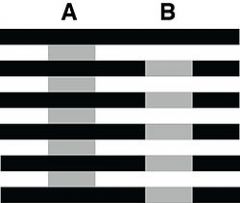![]()
![]()
![]()
Use LEFT and RIGHT arrow keys to navigate between flashcards;
Use UP and DOWN arrow keys to flip the card;
H to show hint;
A reads text to speech;
31 Cards in this Set
- Front
- Back
|
Method of Constant Stimuli |
a psychophysical method in which a number of stimuli with different intensities are presented repeatedly in a random order |
|
|
Method of Limits |
a psychophysical method for measuring threshold in which the experimenter presents sequences of stimuli in ascending and descending order |
|
|
Method of Adjustment |
a psychophysical method in which the experimenter or the observer adjusts the stimulus intensity in a continuous manner until the observer detects the stimulus |
|
|
Top-Down Processing |
knowledge based using info you already know to bring to a situation |
|
|
Bottom-Up Processing |
information based, info coming in from the environment |
|
|
Physiological |
how a person's perception is related to bodily processes |
|
|
Psychophysical |
how a person's perception is related to stimuli in the environment |
|
|
Perceived Magnitude |
a perceptual measure of stimuli, such as light or sound, that indicates the magnitude of experience |
|
|
Measured Intensity (Response Compression and Expansion) |
compression: doubling the physical intensity of a stimulus less than doubles the subjective magnitude expansion: doubling the physical intensity of a stimulus more than doubles the subjective magnitude |
|
|
Lateral Inhibition (Definition) |
inhibition that is transmitted laterally across a nerve circuit |
|
|
How Lateral Inhibition Works |
-suppresses light to a receptor in the retina -though lighting conditions change, percentage of light reflection doesn't reflected light reflectance = --------------------- illumination |
|
|
What Does Lateral Inhibition Achieve |
-gives edge detection, which helps in recognition of objects -absolute brightness is useless; we care about how much light something reflects in a specific environment |
|
|
Belongingness |
-the hypothesis that an area's appearance is influenced by the part of the surroundings that the area appears to belong to -these probabilities are based on past experiences in perceiving properties of objects and scenes |
|
|
White's Illusion |

rectangles A and B appear different, even though they are printed from the same ink and reflect the same amount of light |
|
|
Receptive Fields |
a neuron's receptive field is the area on the receptor surface (the retina for vision) that, when stimulated, affects the firing of that neuron |
|
|
Center-Surround |
arrangement of a neurons receptive field caused by the fact that one is excitatory and and the other is inhibatory decreases the responding of a neuron when stimulated, compared to stimulating the excitatory area |
|
|
Orientation Tuning Curves |
a function relating the firing rate of a neuron to the orientation of the stimulus |
|
|
Selective Adaptation |
a procedure in which a person or animal is selectively exposed to one stimulus, and then the effect of this exposure is assessed by testing with a wide range of stimuli typically, sensitivity to the exposed stimulus is decreased |
|
|
Specificity Coding |
different perceptions are signaled by activity in specific neurons (single neuron for every face) |
|
|
Distributed Coding |
perceptual qualities signaled by pattern of activity across many neurons |
|
|
Sparse Coding |
the idea that a particular neuron is represented by the firing of a relatively small number of neurons |
|
|
Location Column |
a column in the visual cortex that contains neurons with the same receptive field locations on the retina |
|
|
Orientation Column |
a column in the visual cortex that contains neurons with the same orientation preference |
|
|
Cortical Inflation |
-info gets more distorted in a way that makes it more useful -we only need precise, detailed vision for the very center of our view |
|
|
Two Streams |
-what: shape, color, size, identity -where: location, orientation |
|
|
Evidence for the Streams |
Patient D.F. -can't match paper orientation, but can put it in mailslot -Ungerleider and Mishkin suggested that a better description for the "where" stream be the "how", because it determines how a person carries out an action |
|
|
Ganel and Goodale's Block Task |
1. length estimation task: indicate how long a line is by spreading thumb and index finger 2. grasping task: reach toward lines and grasp each line by it's ends; sensors measures separation between subjects fingers and grasped lines |
|
|
Holistic |
concerned with something as a whole rather than it's individual parts |
|
|
Analytic |
examining something's individual parts |
|
|
Face Processing |
some areas have neurons that respond more to faces, but that doesn't mean they won't fire for anything else |
|
|
Expertise Hypothesis |
-greebles -the FFA can be trained to respond to things just as strongly as it does to faces if a person is an expert at discriminating the differences between them (ex. bird watchers and birds, chess players and chess pieces) |

